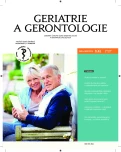Tinnitus – a frequently ignored problem
Authors:
P. Chrbolka; Z. Paluch; Š. Alušík
Authors‘ workplace:
ORL oddělení, Thomayerova nemocnice, Praha
1; Farmakologický ústav 1. LF UK Praha
2; IPVZ, katedra interního lékařství
3
Published in:
Geriatrie a Gerontologie 2015, 4, č. 1: 34-39
Category:
Review Article
Overview
Tinnitus is a common problem with higher prevalence in civilized countries. The basic division distinguishes objective tinnitus, often resulting from vascular anomalies and subjective tinnitus, which is more common and whose aetiopathogenesis is not fully understood. Risk factors for tinnitus are common cardiovascular risks, elevated BMI, hypertension, dyslipidemia, exposure to excessive noise and hearing disorders in general. Also important are the psychological aspects of a particular individual. Tinnitus can be associated with other diseases of the nervous system such as multiple sclerosis or the vestibular schwannoma. Tinnitus can be provoked by selected medication (salicylates, aminoglycoside antibiotics, cytostatics). Treatment of tinnitus is complicated, we recommend different modalities such as pharmacotherapy, physical therapy, psychotherapy and rehabilitation.
Keywords:
tinnitus – hearing impairment – vascular anomalies – depressions – Meniere´s disease – vestibular schwannoma – sclerosis multiplex
Sources
1. Coelho CB, Sanchez TG, Tyler RS. Tinnitus in children and associated risk factors. Prog Brain Res 2007; 166: 179–191.
2. Semaan MT, Megerian CA. Contemporary perspectives on the pathophysiology of Meniere’s disease: implications for treatment. Curr Opin Otolaryngol Head Neck Surg 2010; 18(5): 392–398.
3. Shargorodsky J, Curhan GC, Farwell WR. Prevalence and characteristics of tinnitus among US adults. Am J Med 2010; 123(8): 711–718.
4. Han BI, Lee HW, Kim TY, Lim JS, Shin KS. Tinnitus: characteristics, causes, mechanisms, and treatments. J Clin Neurol 2009; 5(1): 11–19.
5. Deggouj N, Castelein S, Gerard JM, Decat M, Gersdorff M. Tinnitus and otosclerosis B-ENT 2009; 5(4): 241–244.
6. Sanchez TG, Balbani AP, Bittar RS, Bento RF, Câmara J. Lidocaine test in patients with tinnitus: rationale of accomplishment and relation to the treatment with carbamazepine. Auris Nasus Larynx 1999; 26(4): 411–417.
7. Daniell WE, Fulton-Kehoe D, Cohen M, Swan SS, Franklin GM. Increased reporting of occupational hearing loss: workers’ compensation in Washington State, 1984–1998. Am J Ind Med 2002; 42(6): 502–510.
8. Daniell WE, Swan SS, McDaniel MM, et al. Noise exposure and hearing conservation practices in an industry with high incidence of workers’ compensation claims for hearing loss. Am J Ind Med 2002;42(4): 309–317.
9. Møller AR. Tinnitus: presence and future. Prog Brain Res 2007; 166: 3–16.
10. Hahn A, Sejna I, Stolbova K, Cocek A. Combined laser-EGb 761 tinnitus therapy. Acta Otolaryngol Suppl 2001; 545: 92–93.
11. Hahn A, Radkova L, Achiemere G, Klement V, Alpini D, Strouhal J. Multimodal therapy for chronic tinnitus. Int Tinnitus J 2008; 14(1): 69–72.
12. Shulman A, Goldstein B. Subjective idiopathic tinnitus and palliative care: a plan for diagnosis and treatment. Otolaryngol Clin North Am 2009; 42(1): 15–37,
13. Holt AG, Bissig D, Mirza N, Rajah G, Berkowitz B. Evidence of key tinnitus-related brain regions documented by a unique combination of manganese-enhanced MRI and acoustic startle reflex testing. PLoS One 2010; 5(12): 142–160.
14. Toppila E, Koskinen H, Pyykkö I. Hearing loss among classical-orchestra musicians. Noise Health 2011; 13(50): 45–50.
15. Sanchez TG, Medeiros IR, Levy CP, Ramalho Jda R, Bento RF. Tinnitus in normally hearing patients: clinical aspects and repercussions. Braz J Otorhinolaryngol 2005; 71(4): 427–31.
16. Yang Q, Vernet M, Orssaud C, Bonfils P, Londero A, Kapoula Z. Central crosstalk for somatic tinnitus: abnormal vergence eye movements. PLoS One 2010; 5(7).
17. Fornaro M, Martino M. Tinnitus psychopharmacology: A comprehensive review of its pathomechanisms and management. Neuropsychiatr Dis Treat 2010; 6: 209–218.
18. Martines F, Bentivegna D, Di Piazza F, Martines E, Sciacca V, Martinciglio G. Investigation of tinnitus patients in Italy: clinical and audiological characteristics. Int J Otolaryngol 2010; 2010: 265861.
19. Wuertenberger CJ, Rosahl SK. Vertigo and tinnitus caused by vascular compression of the vestibulocochlear nerve, not intracanalicular vestibular schwannoma: review and case presentation. Skull Base 2009; 19(6): 417–424.
20. Pinto PC, Sanchez TG, Tomita S. The impact of gender, age and hearing loss on tinnitus severity. Braz J Otorhinolaryngol 2010; 76(1): 18–24.
21. Chun RH, Pinto JM, Blankenhorn R, Dayal VS. Recovery of otoacoustic emission function in luetic endolymphatic hydrops: a possible measure of improvement in cochlear function. Int J Otolaryngol 2009; 2009: 942096.
22. Shim HJ, Kim SK, Park CH, Lee SH, Yoon SW, Ki AR, Chung DH,Yeo SG. Hearing abilities at ultra-high frequency in patients with tinnitus. Clin Exp Otorhinolaryngol 2009; 2(4): 169–174.
Labels
Geriatrics General practitioner for adults Orthopaedic prostheticsArticle was published in
Geriatrics and Gerontology

2015 Issue 1
- Metamizole vs. Tramadol in Postoperative Analgesia
- Memantine in Dementia Therapy – Current Findings and Possible Future Applications
- Memantine Eases Daily Life for Patients and Caregivers
- Metamizole at a Glance and in Practice – Effective Non-Opioid Analgesic for All Ages
- Advances in the Treatment of Myasthenia Gravis on the Horizon
Most read in this issue
- Acute pancreatitis, a feared diagnosis among the elderly
- Tinnitus – a frequently ignored problem
- Quality of life of residents in facilities for seniors
- Tuberculosis in old age
